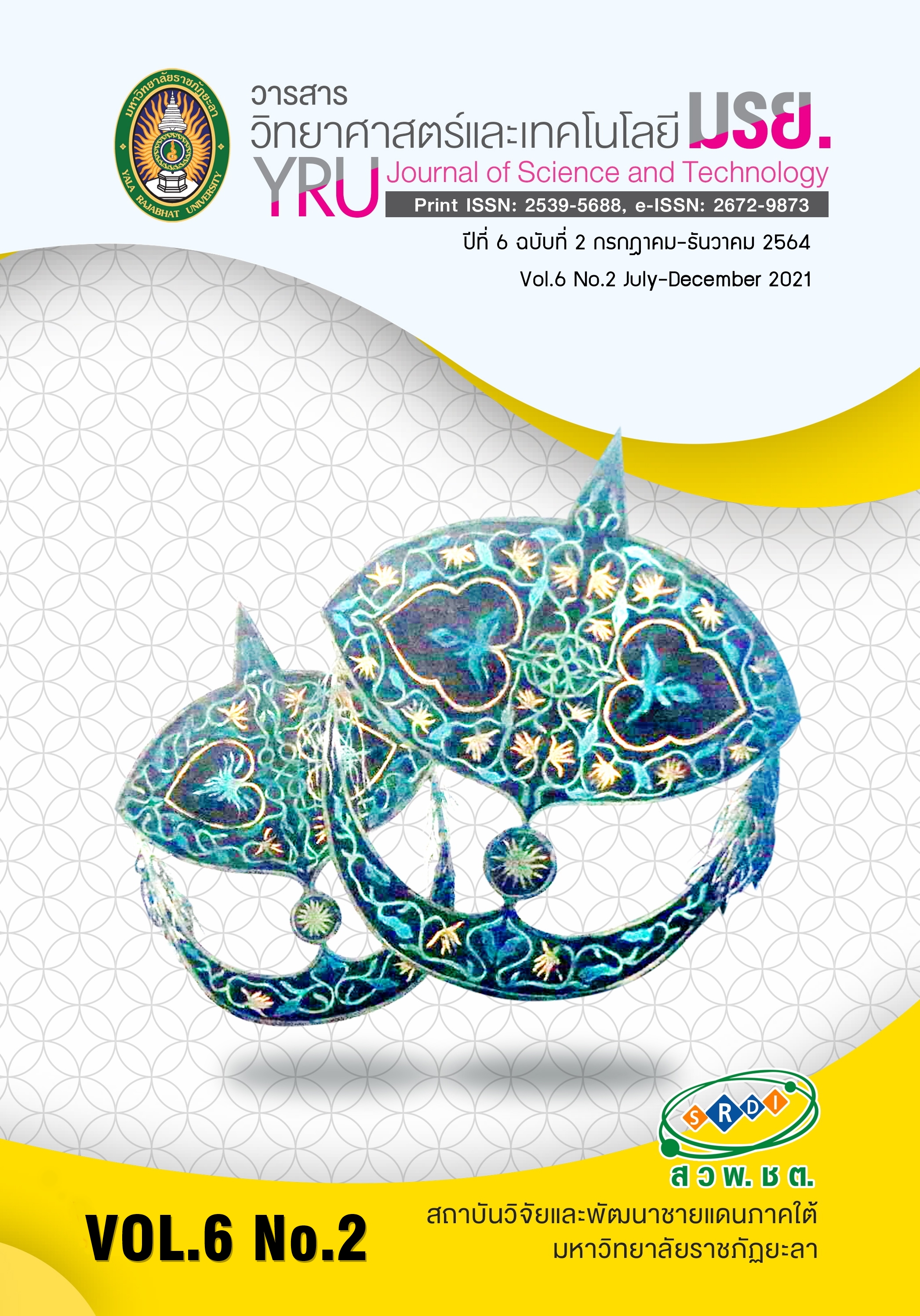Product Development of Reduced Fat Chicken Emulsion-Type Sausage Using Carrageenan and Soy Protein Isolate
Main Article Content
Abstract
Sausage is a popular processed consumer product. Rather, it is a product with a high content of saturated fat, the product therefore has been developed to reduce fat content by using carrageenan and soy protein isolate as replacement. The objective of this research was to study the optimal content of fat, carrageenan and soy protein isolate in reduced fat chicken sausage products. The experiment is planned using Mixture design to determine three main factors: 0.50-0.70 fat refers to 5.00-7.00% main ingredient, carrageenan 0.10-0.30 refers to carrageenan 1.00-3.00% main ingredient and soy protein isolate 0.20-0.35 refers to soy protein isolate 2.00-3.50% main ingredient. The three factors had a statistically significant effect on hardness, fracturability, cohesiveness, and fat content (p < 0.05). The optimal formulation of three components consisted of fat 0.56, carrageenan 0.17, and soy protein isolate 0.27, which meant fat 5.6% in the main ingredient, carrageenan 1.70% in the main ingredient, and soy protein isolate 2.70% in the main ingredient. The principle of using optimal formulation caused the result in hardness at a value of 57.31 N, cohesiveness value of 0.40, springiness value of 0.82, fracturability value of 0.08 N and adhesiveness -0.31 N/s. In terms of nutritional value, the product had a protein content of 14.14%, fat content of 4.16% and calories content of 122.80 kcal/100 g. Therefore, using carrageenan and soy protein isolate together can reduce the fat content in chicken sausage. It improves the texture of the product and generates alternative products for health
Article Details
บทความ ข้อมูล เนื้อหา รูปภาพ ฯลฯ ที่ได้รับการเผยแพร่ในวารสารวิทยาศาสตร์และเทคโนโลยี มรย. นี้ ถือเป็นลิขสิทธิ์ของวารสารวิทยาศาสตร์และเทคโนโลยี มรย. หากบุคคลหรือหน่วยงานใดต้องการนำทั้งหมดหรือส่วนหนึ่งส่วนใดไปเผยแพร่ต่อหรือกระทำการใดๆ จะต้องได้รับอนุญาตเป็นลายลักษณ์อักษรจากวารสารวิทยาศาสตร์และเทคโนโลยี มรย. ก่อนเท่านั้น
References
Amini Sarteshnizi, R., Hosseini, H., Mousavi Khaneghah, A., & Karimi, N. (2015). A review on application of hydrocolloids in meat and poultry products. International Food Research Journal, 22(3), 872-887
Angor, M. M., & AL‐ Abdullah, B. M. (2010). Attributes of low-fat beef burgers made from formulations aimed at enhancing product quality. Journal of Muscle Foods, 21(2), 317-326.
AOAC. (2000). Official methods of analysis of AOAC international. 17th ed. Verginia, USA: Association of Official Analysis Chemists.
Asuming-Bediako, N., Jaspal, M. H., Hallett, K., Bayntun, J., Baker, A., & Sheard, P. R. (2014). Effects of replacing pork backfat with emulsified vegetable oil on fatty acid composition and quality of UK-style sausages. Meat science, 96(1), 187-194.
Atashkar, M., Hojjatoleslamy, M., & Sedaghat Boroujeni, L. (2018). The influence of fat substitution with κ‐carrageenan, konjac, and tragacanth on the textural properties of low‐fat sausage. Food science & nutrition, 6(4), 1015-1022.
Campo, V. L., Kawano, D. F., da Silva Jr, D. B., & Carvalho, I. (2009). Carrageenans: Biological properties, chemical modifications and structural analysis–A review. Carbohydrate polymers, 77(2), 167-180.
Chiang mai livestock product research and development center. (2018). European products: Ham, Gerrnan sausage, bacon. Chiang mai: Division of livestock products. (in Thai)
Choi, Y., Choi, J., Han, D., Kim, H., Lee, M., Kim, H., Lee, J., Chung, H. & Kim, C. (2010). Optimization of replacing pork back fat with grape seed oil and rice bran fiber for reduced-fat meat emulsion systems. Meat Science. 84(1), 212-218.
De Souza Paglarini, C., Martini, S., & Pollonio, M. A. R. (2019). Using emulsion gels made with sonicated soy protein isolate dispersions to replace fat in frankfurters. LWT, 99, 453-459.
Juntachote, T. (2018). Influence of carrageenan addition on physico-chemical and sensory properties of low fat chicken sausages. Journal of King Mongkut’s University of Technology North Bangkok, 28(3), 605-616. (in Thai)
Nasonova, V. V., & Tunieva, E. K. (2019). A comparative study of fat replacers in cooked sausages. In The 60th International Meat Industry Conference, September 22–25 2019, Kopaonik-Serbia: IOP Publishing
Nutrition Division. (2003). Dietary reference intake for Thais 4th edition. Bangkok. Ministry of Public Health. (in Thai)
Panyathitipong, W., and Puechkamut, Y. (2010). Effect of tofu powder and carrageenan on functionality and physical characteristics of surimi emulsion gel. Kasetsart J (Nat Sci), 44(4), 671-679.
Rattanapanon, N. (2014). Food chemistry. Bangkok: Odeon Store Publisher. (in Thai)
Sun, L., Chen, W., Liu, Y., Li, J., & Yu, H. (2015). Soy protein isolate/cellulose nanofiber complex gels as fat substitutes: rheological and textural properties and extent of cream imitation. Cellulose, 22(4), 2619-2627.
Thai Industrial Standards Institute. (2012). Thai community product standard of chicken sausage (TCPS 331/2012). Bangkok: Ministry of Industry. (in Thai).
The office of industrial economics. (2019). Thailand domestic sales: ham, sausage, bacon [Online]. Retrieved December 7, 2019, from: https://www.ceicdata.com/en/thailand/domestic-sales-office-of-industrial-economics-isic-rev-4.
Youssef, M. K., & Barbut, S. (2011). Fat reduction in comminuted meat products-effects of beef fat, regular and pre-emulsified canola oil. Meat Science, 87(4), 356-360.
Zouari, N., Ayadi, M. A., Hadj-Taieb, S., Frikha, F., & Attia, H. (2012). Whey powder, ι-carrageenan, and fat interactions and their influence on instrumental texture and sensory properties of turkey meat sausage using a mixture design approach. International journal of food properties, 15(6), 1233-1246.


